Dell 2407WFP and 3007WFP LCD Comparison
by Jarred Walton on March 2, 2007 11:30 AM EST- Posted in
- Displays
Dell 3007WFP: Appearance and Design
The 3007WFP is almost a direct clone of the 2407WFP, at least in terms of the outward appearance. It's basically the big brother -- and we definitely mean BIG! Most users already think that a 24" LCD is pretty large, but the 2407WFP is absolutely dwarfed by the 3007WFP.
Other than the change in size, most of our commentary about the 2407WFP applies to the 3007WFP. It's attractive and it comes with a base stand that allows a reasonable amount of travel (about four inches).
You get tilt, swivel, and height adjustment courtesy of the base stand. If you prefer, you can also remove the base stand and use a standard 100mm VESA wall mount. Unlike the 2407WFP, there's no ability to rotate the display. Considering the size of the panel, that is to be expected -- you would need a base stand with about six inches of vertical travel to even be able to accommodate the increased height of portrait mode.
The rear of the display is relatively nondescript, but all of the connection ports are facing downwards so they aren't immediately visible.
As far as input ports go, as mentioned earlier only a single DVI port is present and the display requires a dual-link capable graphics card in order to run at its native 2560x1600 resolution. The 3007WFP can still function as a USB hub, and the USB input as well as two USB ports are located on the back of the display. Besides the main power connection, a power socket for an optional speaker bar is once again present.
Like the 2405FPW and 2407WFP, the left side provides two additional USB ports along with a flash memory reader. The same flash memory types as the 2407WFP are supported via the 9-in-2 reader.
Describing the On-Screen Display for the 3007WFP is extremely simple: there is no OSD! At the bottom of the display are three buttons: power, increase brightness, and decrease brightness. There are 20 levels of backlight intensity, but there's no immediate indication of your current setting. This is definitely taking minimalism to an extreme, and while many of the other features usually present in an OSD are unnecessary considering there is only one video input available, we really would have liked to see at least a few more options.
Speaking of options, we would also really like to see more video input choices. Granted, no analog signals are going to be capable of driving 2560x1600 resolution without experiencing signal degradation, but the 3007WFP does a good job at scaling non-native resolutions so it still should have been possible to include a VGA connection as well as component inputs and simply limit the maximum resolution with those connections to 1920x1200. We would also really like to be able to run single-link DVI at resolutions above 1280x800.
As it stands, the 3007WFP is intended pretty much only for use with a computer. Considering a 30" LCD is larger than a lot of people's televisions, it seems a shame to limit the versatility of the display.
30 Inch vs. 24 Inch
Having used both of these LCDs for a while, we felt it might be useful to provide our impressions of the experience. We used 21" CRTs for a long time, but the upgrade to a 24" LCD still broght noticeably more screen area. Personally, I held out switching to LCDs due to concerns about refresh rates and pixel response times, but when I finally upgraded to a 24" LCD (the 2405FPW), I was extremely pleased with the result. Some people still have complaints about LCDs versus CRTs, but overall we feel the benefits far outweigh the negatives and all of us are more than happy using LCDs on a daily basis.
If a 24" LCD feels pretty large compared to a 21" CRT (despite the fact that it weighs about one third as much), a 30" LCD is absolutely huge. Provided your eyesight is good enough, you almost feel the need to sit back several feet further away from the computer. Of course, the native resolution is such that icons and text are actually slightly smaller than what they would be on a 24" LCD, and if you end up sitting close to the screen like most people a 30" LCD can almost feel too big.
Another potential problem with such large LCDs is that they can require a ton of graphics power in order to run games at their native resolution. A single fast graphics card like a Radeon X1900 XT is generally sufficient for running most modern games at 1920x1200, but until the launch of the GeForce 8800 series it simply wasn't practical to play most games at 2560x1600 without dual GPUs. Even if you've got the graphics horsepower, configuring some games to run at the native resolution can be a pain, although thankfully this is getting better with time.
24" LCDs are pretty expensive still, and 30" LCDs are even more so, so before going out and spending a lot of money on a large LCD you will definitely want to try one out in person. Provided you have the hardware, using a 30" LCD is a really enjoyable experience for gaming and multitasking, at least from our perspective. Not everyone feels that way, however, and considering the price we feel that the 22"-26" LCDs are currently the sweet spot. You could purchase two 24" LCDs for the price of a 30" LCD right now, and there are also plenty of desks where it simply isn't practical to try and use a 30" display. If you've got the money and desk space, however, a 30" LCD definitely won't disappoint -- it just might take a little time to get used to having such a huge monitor.
The 3007WFP is almost a direct clone of the 2407WFP, at least in terms of the outward appearance. It's basically the big brother -- and we definitely mean BIG! Most users already think that a 24" LCD is pretty large, but the 2407WFP is absolutely dwarfed by the 3007WFP.
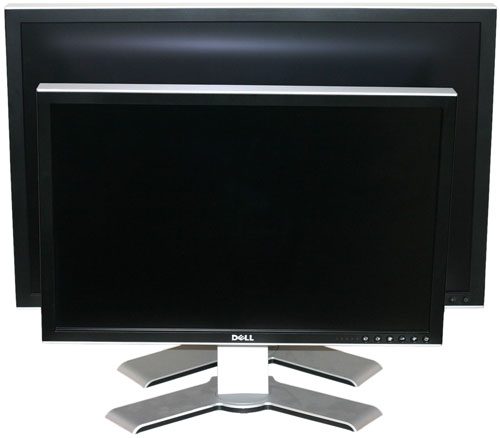 |
| Click to enlarge |
Other than the change in size, most of our commentary about the 2407WFP applies to the 3007WFP. It's attractive and it comes with a base stand that allows a reasonable amount of travel (about four inches).
 |
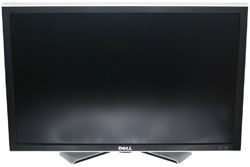 |
| Click to enlarge | |
You get tilt, swivel, and height adjustment courtesy of the base stand. If you prefer, you can also remove the base stand and use a standard 100mm VESA wall mount. Unlike the 2407WFP, there's no ability to rotate the display. Considering the size of the panel, that is to be expected -- you would need a base stand with about six inches of vertical travel to even be able to accommodate the increased height of portrait mode.
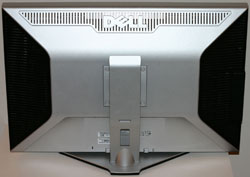 |
| Click to enlarge |
The rear of the display is relatively nondescript, but all of the connection ports are facing downwards so they aren't immediately visible.
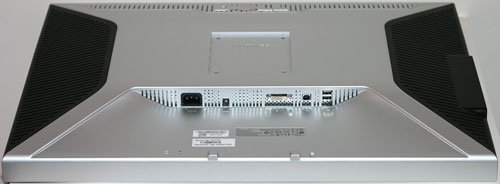 |
| Click to enlarge |
As far as input ports go, as mentioned earlier only a single DVI port is present and the display requires a dual-link capable graphics card in order to run at its native 2560x1600 resolution. The 3007WFP can still function as a USB hub, and the USB input as well as two USB ports are located on the back of the display. Besides the main power connection, a power socket for an optional speaker bar is once again present.
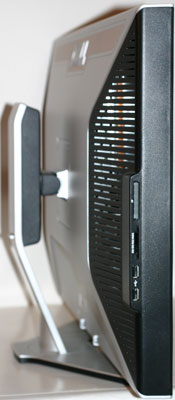 |
| Click to enlarge |
Like the 2405FPW and 2407WFP, the left side provides two additional USB ports along with a flash memory reader. The same flash memory types as the 2407WFP are supported via the 9-in-2 reader.
Describing the On-Screen Display for the 3007WFP is extremely simple: there is no OSD! At the bottom of the display are three buttons: power, increase brightness, and decrease brightness. There are 20 levels of backlight intensity, but there's no immediate indication of your current setting. This is definitely taking minimalism to an extreme, and while many of the other features usually present in an OSD are unnecessary considering there is only one video input available, we really would have liked to see at least a few more options.
Speaking of options, we would also really like to see more video input choices. Granted, no analog signals are going to be capable of driving 2560x1600 resolution without experiencing signal degradation, but the 3007WFP does a good job at scaling non-native resolutions so it still should have been possible to include a VGA connection as well as component inputs and simply limit the maximum resolution with those connections to 1920x1200. We would also really like to be able to run single-link DVI at resolutions above 1280x800.
As it stands, the 3007WFP is intended pretty much only for use with a computer. Considering a 30" LCD is larger than a lot of people's televisions, it seems a shame to limit the versatility of the display.
30 Inch vs. 24 Inch
Having used both of these LCDs for a while, we felt it might be useful to provide our impressions of the experience. We used 21" CRTs for a long time, but the upgrade to a 24" LCD still broght noticeably more screen area. Personally, I held out switching to LCDs due to concerns about refresh rates and pixel response times, but when I finally upgraded to a 24" LCD (the 2405FPW), I was extremely pleased with the result. Some people still have complaints about LCDs versus CRTs, but overall we feel the benefits far outweigh the negatives and all of us are more than happy using LCDs on a daily basis.
If a 24" LCD feels pretty large compared to a 21" CRT (despite the fact that it weighs about one third as much), a 30" LCD is absolutely huge. Provided your eyesight is good enough, you almost feel the need to sit back several feet further away from the computer. Of course, the native resolution is such that icons and text are actually slightly smaller than what they would be on a 24" LCD, and if you end up sitting close to the screen like most people a 30" LCD can almost feel too big.
Another potential problem with such large LCDs is that they can require a ton of graphics power in order to run games at their native resolution. A single fast graphics card like a Radeon X1900 XT is generally sufficient for running most modern games at 1920x1200, but until the launch of the GeForce 8800 series it simply wasn't practical to play most games at 2560x1600 without dual GPUs. Even if you've got the graphics horsepower, configuring some games to run at the native resolution can be a pain, although thankfully this is getting better with time.
24" LCDs are pretty expensive still, and 30" LCDs are even more so, so before going out and spending a lot of money on a large LCD you will definitely want to try one out in person. Provided you have the hardware, using a 30" LCD is a really enjoyable experience for gaming and multitasking, at least from our perspective. Not everyone feels that way, however, and considering the price we feel that the 22"-26" LCDs are currently the sweet spot. You could purchase two 24" LCDs for the price of a 30" LCD right now, and there are also plenty of desks where it simply isn't practical to try and use a 30" display. If you've got the money and desk space, however, a 30" LCD definitely won't disappoint -- it just might take a little time to get used to having such a huge monitor.










62 Comments
View All Comments
Resh - Saturday, March 3, 2007 - link
Thanks Jarred!I wouldn't expect you to print and assess accuracy, but if you could do a photo-specific calibration and test for future reviews, that would be great.
Thanks again and keep up the good work!
BPB - Friday, March 2, 2007 - link
I have two questions. In the Gateway review you mentioned the Gateway did a good job of showing 16:9 movies with the black bars and that the Gateway did 1:1 very well. You also mentioned that you heard the Dell maybe didn't do it as well. So the first question is: did you try this in your test? I just bought the Gateway and like it (I opened the box last night, hours before you posted this review), but I plan on using it to watch DVD's while I work out, as well as using it as my main monitor.The second question is does the Dell have auto-rotate software like Gateway's EzTune? I was told by a Dell rep that it doesn't and that you have to manually change the video drivers. I like to use rotate when working on a website. I can often fit an entire site up and down when rotated. At most I have to scroll very little.
Oh well, looks like I may have to beg BestBuy to take the FPD2485W back and head up to Costco for the Dell if the Dell does DVD's as well. Of course then the Dell would be a little more as I didn't pay tax or shipping for the Gateway (thanks, NH!) but would have to pay tax for the Dell (arghh to you, MA) making the $5 list price favor of the Dell become a $28.70 favor for the Gateway. I paid $679.99 for the Gateway, the Dell becomes $707.70 with tax.
JarredWalton - Friday, March 2, 2007 - link
Dell locks the scaling to what your drivers specify if you use DVI. ATI doesn't allow 1:1 scaling as far as I know, but they do allow a centered 1:1 image (i.e. black bars). NVIDIA has better options for changing scaling, although I have encountered bugs in the past with their 1:1 scaled option. The Gateway does have controls more like the old 2405FPW (where you could set scaling via the monitor rather than in drivers), but the colors aren't as good overall. In terms of DVD playback, neither display is really good (i.e. less than 3 delta E), and I don't know that subjectively I can see a big difference between the Dell and GW when watching videos. You can always disable DirectDraw to get the color profile applied (it disables overlay)... heh.JarredWalton - Friday, March 2, 2007 - link
Oh, I forgot to say, I don't think there's an auto-rotate software with the Dell. Also, I'm not sure EZtune handles the auto-rotate - I thought it was a function of the drivers, but I could be wrong. I'll have to test it later... right now I need sleep! ;)BPB - Friday, March 2, 2007 - link
Thanks for the quick reply. I had a Gateway 21" before getting the 24" and can attest to the EzTune doing the auto-rotate. It's a very nice feature. Not a deal-breaker type of thing, but it's nice. When I consider the effort it will take to return the Gateway to get the Dell I start to think it probably ain't worth it, the effort, that is.chizow - Friday, March 2, 2007 - link
The 2407WFP REV A04 does 1:1 scaling. It looks like Jarred got an A03 or earlier for the review. I saw the 1:1 scaling option greyed out in the OSD but didn't see it directly mentioned in the review anywhere.Jarred, you gotta include this kind of stuff in your reviews! Its what panel buyers want to know. Also was the 3007 the HC version or standard?
Otherwise nice review; the difference between the 2407 and the FPD2485W is spot-on with my own observations from using both first hand. The one test I felt was flawed was comparing the 2405 and 2407 for input lag. A better test imo would've been testing the 2407 to the FPD2485W or even a 2ms TN or S-IPS. IIRC the 2405 had input lag problems as well, so any lag wouldn't really show when comparing the two.
JarredWalton - Friday, March 2, 2007 - link
I'll see about taking a shot of the FPD2485W vs. 2407WFP for input lag - again, I've never had any issue, but maybe I'm just getting too old and my eyes are slow? :)The LCD I have is revision A01, so some things have apparently changed. Sort of interesting, as I have only had the LCD for a few months... I would have expected something made more recently. I guess Dell hasn't made a point of pushing newer revisions, which isn't too surprising. The 3007 is the standard version as far as I can tell - wouldn't the new HC be a separate model, or are they simply phasing out the older IPS model and moving to a TN or whatever version instead?
chizow - Friday, March 2, 2007 - link
I didn't think it would be that big of a deal either, but after having used both, it is slightly noticeable. Part of it might be psychological, but there's some pretty convincing tests out there that show the input lag can be pretty severe. Similar to your test, they had side-by-side screens where ammo counters were off by 1-2 rounds, objects were in different positions, and other anomalies.Wow A01, surprised it didn't exhibit more serious banding problems. Maybe it was a refurb? The A01 and A02 were supposed to exhibit banding problems similar to the Gateway. But ya Dell is horrible with their panel lottery; if they shipped you guys a panel gratis it was probably a refurb or recycled panel. Makes a lot of sense shipping an old panel to a well-known review site!
The HC is being treated as a new revision afaik. Its been in Asian markets since the new year and has only become available in the US recently to select customers. I think it will eventually just replace the older versions in the channel when it reaches widespread availability. I'm also pretty sure its still IPS, it just increases brightness/contrast since that was the biggest knock on the 3007 apparently.
BPB - Friday, March 2, 2007 - link
I just saw your reply in the forums. Thanks!BPB - Friday, March 2, 2007 - link
So you too would recommend the Dell over the Gateway? If so, would you say like Jarred that the difference is minimal or would you say it's more than minimal?